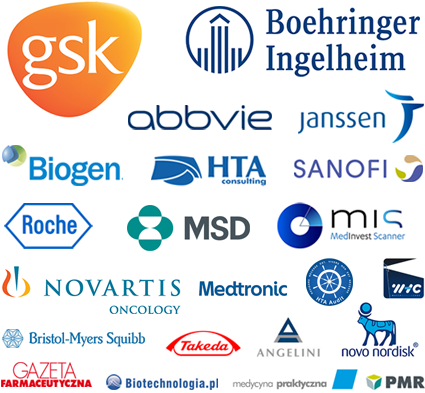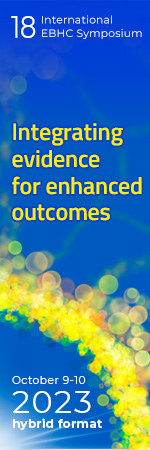 |
||
 
| ||
|
Activity
|
10th International EBHC Symposium 2015
"Disinvestment by HTA & Pricing. How can we better address health needs?"  Preliminary programme EBHC Symposium 2015 (500 kB) Preliminary programme EBHC Symposium 2015 (500 kB)Editions: 2006 | 2007 | 2008 | 2009 | 2010 | 2011 | 2012 | 2013 | 2014 | 2015 |
The Symposium took place in Krakow on December 14th and 15th, 2015 in Park Inn Hotel.
This year during the annual EBHC symposium, CEESTAHC will tackle the issue of excessive burdening of the basic benefit package. The main issue is managing the guaranteed services package in a way in which financial resources indeed guarantee those services. What can be done to control the contents of the package? What can be done to eliminate the deficit understood as the disparity between the contents of the package and the funds allocated to its implementation? What can be done to make the system more fair? Where can we find additional funding for add value medical technologies in order to prevent a deficit and waiting lists to basic healthcare services?
The basic benefit package is a tool which, like any other tool, in order to function correctly, requires proper handling, reviews and maintenance. The technologies included in the package should be periodically reassessed and, if need be, replaced by better alternatives. Meanwhile, the Polish basic benefit package is a walk down the memory lane rather an active area for finding better solutions. When, after undergoing a lengthy assessment process (usually the case of drugs), a technology is included in the package, theoretically it can stay there "forever". New technologies are added to the package and with time actual heaps are created - forgotten, musty, difficult to assess and difficult to remove, as there is no one who would take on that task. The Polish Agency for Health Technology Assessment and Tariff System (AOTMiT) assesses nearly only drug technologies and operates on a thin line between innovative drugs and the guaranteed services package. AOTMiT virtually never deals with non-drug technologies and completely fails to revisit the "guaranteed" service package in order to makes space for new health technologies and relocate funds for innovations. The hope lies with launching the Tariff System Agency – however, will the adopted valuation methods be able to ensure the expected efficiency?
Removing a health technology from the basic benefit package once it is included is very difficult in our country. One problem is the lack of experience in this type of operations, another is the significant risk that the competing political option will use this against the incumbents. Their opponents will not hesitate to horrify the public with their political rivals' "totalitarian" inclinations or to persuade confused patients to appear before the doors of the key authorities as part of "spontaneous social protests". Usually in such cases the situation starts spinning out of control and politically-motivated decisions replace the rational ones.
Despite these difficulties many countries have systems in force allowing for efficient "fine-tuning" of the basic benefit package. It is helpful to learn about these solutions, especially since the right procedures took decades to develop. You will get the chance to know them in December. We invite you wholeheartedly to participate in the Symposium.
Partners of 10th EBHC Symposium
 Schedule
The scientific program of the Symposium was presented over two days in seven main thematic sessions:
Speakers
Sessions
Session 2
The perspective of health technology assessment analyses
Health is one of the greatest values both for the individual and for society as a whole, and its protection is inextricably linked with the State's responsibilities. In the past few years there has been an intense discussion on the healthcare policy model, the scope of financing services and decision-taking in healthcare. Implementation of goals set out for the State is becoming increasingly difficult due to:
In the context of challenges faced by decision-makers in the field of health policy, data on indirect costs generated due to reduced productivity of patients constitutes valuable information, which so far has been underestimated. Analyses extended by assessments of lost productivity make it possible to view a disease not only as an issue affecting the patient directly, but also help see the negative consequences of the disease to the society as a whole.
This session is devoted to a further discussion on the social perspective – its constraints, scope of data and the possibility of being applied in health technology assessment. You will learn in particular about the experiences of Great Britain and Scotland.
Session 4
Therapeutic session: How can some order be introduced to the basic benefits package?
In Poland, the guaranteed benefits package has been discussed by experts since the late 1990s. At the same time the "benefits package" is a popular political slogan which is supposed to be an antidote to the problems suffered by the Polish healthcare system. This slogan keeps being used by political parties in their policy programmes, however no details or suggestions for changes are actually given. So what can a basic benefit package be? A positive list, a negative list or a combination of both these types? Have we created a closed list of guaranteed technologies which allows us to precisely determine what a patient is entitled to in the Polish healthcare system? Is it possible to define it through specifications related to a health technology? If so, in what timeline and scope?
Some elements of the system are subject to change, but the key problem – deficit in healthcare – remains the same. In other words, it's not like we have too little money on health care, nor are there few benefits in the package. The problem is that we have to determine what is most necessary from the society's perspective and introduce conditions which would ensure access to healthcare services. Firstly, it must be determined which services are needed the most.
Foreign guests invited to participate in this session have specialised in the issue of guaranteed packages for many years, and the Polish speakers take part in shaping the final form of the package in Poland. We might witness a very interesting confrontation.
Session 5
Role of a tariff system agency
Since 1 January 2015, pursuant to the Act of 27 August 2004 on health care benefits financed from public funds (Journal of Laws 2015, item 581, as amended), the scope of activities of the Polish Agency for Health Technology Assessment also includes valuation of health care services.
Before that date, entities applying for inclusion of a health technology into the guaranteed benefits package were required under applicable provisions of law to provide a cost analysis conducted from the perspective of the payer and sometimes also from the social perspective. Cost analyses (micro-costing) were performed primarily for reimbursement, and not pricing decisions. That is why they concern mainly expensive innovative technologies compared with alternative technologies.
The Agency's new responsibilities will include the following tasks:
According to experts, ensuring actual, reliable valuation of health services could reduce queues to doctors and promote the most cost-effective services or forms of care which are scarce. The central question is whether valuation of services carried out only on the basis of historical data will prove to be an effective tool. Taking into account only retrospective data results in the process disregarding some important elements, such as queues, actual needs, and most of all, the need to shape the scope and form of healthcare in the future. This fits into the real-world data trend which more and more countries start to take into account when planning actions to be taken in their healthcare systems.
During this session we want to show examples of activities taken by tariff system agencies from other countries (i.a. Germany), their scope of responsibilities, methodology and potential problems with valuation.
Session 6
Innovative Oncological Care Fund
The guaranteed benefits package in Poland becomes increasingly less open to new technologies, including actual innovations. There are still over 250 innovative drug technologies and approximately 1000 innovative non-drug technologies not included in the Polish guaranteed benefits package. This situation particularly affects cancer patients who are fighting a hopeless battle, knowing that there is a drug out there which could save their life, but which they can't afford.
In the years to come, more and more newly-created health technologies will remain outside the financial capacities of public funds. The main impediments are budget shortages, intensified by the global crisis and complicated legal regulations governing management of the guaranteed benefits package. Other Central and Eastern European Countries and middle-income countries worldwide struggle with similar problems. The main barrier is lower GDP per capita than in the case of high-income countries and its consequence: a smaller GDP percentage spent on healthcare. Innovative technologies first enter the wealthiest and largest markets in the world. And therefore their pricing, which constitutes the basis for economic analyses, becomes a significant barrier which makes them beyond reach. In many cases it takes several years for an innovative drug to be granted reimbursed, until its price erodes. In the meantime, Polish oncological patients do not have access to health technologies which constitute latest achievements of modern medicine and which could help them.
In order to improve this situation, the idea of the Innovative Oncological Care Fund (Polish: Fundusz Walki z Rakiem; FWR) was created, which aims at ensuring the availability of innovative methods for treatment and diagnosis of neoplastic diseases. The Innovative Oncological Care Fund will make it possible to bypass the inefficient financial system and, thanks to its independence from central regulations, will be free to operate in line with evidence-based healthcare (EBHC). However, this is not supposed to be "luxury insurance for the chosen ones". It is based on several principles which set out its direction for development and regulate its activity:
Many experienced policymakers of the Polish healthcare will cry out: "Counterrevolution!", but such solutions are already being used worldwide. Funds created to improve access to oncological innovations have been established in the UK and Australia – whose healthcare systems are among the best ones.
Session 7
Real World Evidence
All over the world there is a growing awareness that randomised trials, which for many years had been treated as the only "absolute assessment" of a therapy's efficacy, do not reflect the full spectrum of a health technology's use. The aim of a real-world evidence analysis is to supplement the process in order to help make better economic decisions, in particularly in a long-time horizon – like in the case of reimbursement.
Interest in the new approach is getting stronger not only due to the possibility of determining actual effectiveness, but also the method of studying types of populations, types of doctors' behaviour, the degree of adherence or compliance, the profile of adverse effects or costs.
The definition of real-world data (or real-life data) varies, but in its broadest scope it covers all studies apart from phase III of trials (in line with the ISPOR definition) and is currently implemented with regard to relative effectiveness or comparative effectiveness. And thus each payer, when analysing its databases, can publish data related not only to effectiveness, but also processes and costs. All observations made in the healthcare system may be treated as real-life data.
In this session we want to discuss the possibilities of using new analytical methods. We will demonstrate what methodological problems are related to the implementation of specific types of solutions. We will present data which can be collected in the following areas:
Download
|
|
| © Ceestahc.org Wykonała: Agencja A.R.T. Wyświetleń:4526, Data modyfikacji:2016-09-08 | ||

 Preliminary programme EBHC Symposium 2015 (500 kB)
Preliminary programme EBHC Symposium 2015 (500 kB)

